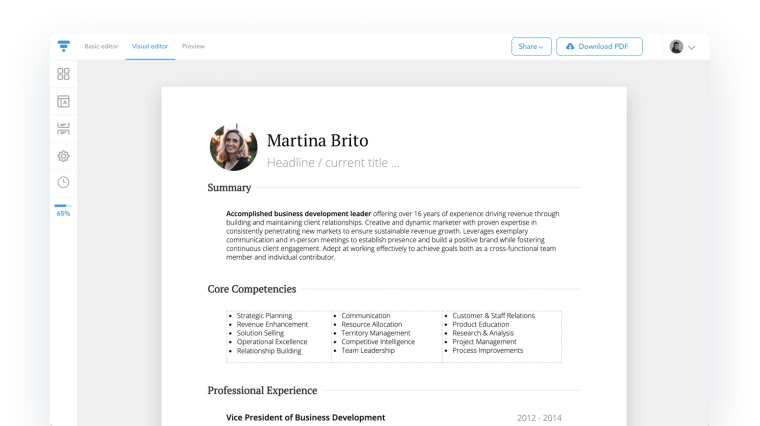![How to convert a resume to a CV [with examples]](/static/bbef40c0f98fc78ed23945501e986214/e1956/laptop-with-resume.jpg)
How to convert a resume to a CV [with examples]

During your job search, you may encounter a job posting that asks for a CV instead of a resume. While this can mean a couple different things depending on the position, it is important to know how to convert a resume to a CV so that you are ready for any application.
Recommended links:
- Our collection of 500+ professional resume examples.
- Our gallery of 20+ downloadable resume templates.

What is the difference between a resume and a CV?
Though resumes and CVs are used for a similar purpose—to apply for jobs—they are different in several important ways.
A resume is a short document, usually one or two pages, that markets you as a good candidate for a job and is customized for every new application. It focuses on the most relevant work experience and achievements in your career history. In the US and Canada, it is used for nearly all job applications.
A CV is a longer document that gives a detailed account of your education and work history. It can be as many pages as it needs to be, and it will contain all of your work history, education, research experience, publications, presentations, conferences, awards, certifications, and sometimes more. In the US and Canada, CVs are used primarily in academia, and are not common in other fields.
In short, a resume is a brief marketing document where you give only your most relevant and impressive details, whereas a CV is a long, inclusive rendering of your entire career and education.
Resumes vs CVs: Key differences
- Length: While resumes tend to be one or two pages long, CVs can be several pages long.
- Detail: Resumes only include the details that are most relevant to the job at hand; CVs leave nothing out.
- Emphasis: Resumes focus on your achievements and emphasize the skills, work experience, and qualifications that are relevant to the position you are applying for; CVs emphasize scholastic accomplishment, teaching experience, research, and other academic information.
- Sections: Resumes typically have a Summary, Work History, and Education section, and may include Skills, Certifications, and Volunteering sections; CVs have many more sections, including Publications, Research, Presentations, Awards, and more.
- Field: Resumes are used in nearly all industries and are much more common than CVs; CVs are usually used for academic and research positions.
When should you use a CV?
Generally, you should use a CV only if it is specifically requested. In America, CVs are primarily used for academic positions. This may be teaching, tutoring, research, and others. Though some medical institutions or senior research positions in private companies may ask for a CV, for the most part, a resume is used outside of academia. If you are unsure, feel free to reach out to the employer to ask.
Keep in mind, however, that these are the American definitions. In some countries, such as the United Kingdom the term “CV” refers to what Americans would call a resume, and in others, such as Australia, the terms “CV” and “Resume” are used interchangeably. Before you submit a CV, make sure you know what specifically is being asked for.
Further, the CV requirements in each country may not be the same. Some countries may expect your CV to include your picture, your age, your address, and more. When you are writing a resume or CV for a different country, make sure it includes all the right details.
How do you convert your resume to a CV?
When it comes time to write a CV, you don’t have to throw out your resume and start from scratch. There are some steps you can take to convert your resume into a great CV.
1. Use the right format
It is best to use a traditional format for a CV. Institutions requiring a formal CV are likely conventional, and will be expecting a classic CV template. Be sure that your CV is professional and supports as many pages as you need. Stay away from anything too colourful or complicated.
2. Add the right personal details
Your CV may need more personal information than a resume, especially if you are sending your CV to a different country. Whereas your resume likely only has your name, contact information, and city, a CV may require things like your address, your age, or your academic advisor’s name. Make sure the applications requirements are clear when you write your personal information on your CV.
3. Add to your work experience
Make sure that your CV includes all of the responsibilities and key accomplishments in your previous roles. Whereas a resume is focused on only your best and most impressive achievements, a CV has the space to be more comprehensive.
4. Add to your education
As CVs are usually used for academic positions, the education section is very important. Your CV should include information like specialty, research area, awards, GPA, and whatever else is relevant to the position. It is important to give an in-depth look at your education.
5. Create new sections as needed
A CV should be comprehensive. As space is not a constraint as it is with a resume, your CV can have as many sections and pages as you need to showcase your experience. The standard Work Experience, Education, and Skills sections of a resume likely won’t be enough for your academic CV.
New CV sections may include:
- Research experience: This section may include any research projects you were a part of, lab time you accumulated, and experiments you participated in. The details of this section will depend on your field, so think carefully about what research you have taken part in.
- Publications: Any articles, book chapters, reports, or research papers that you have written are important to include in your CV. List these in the appropriate citation style for your field.
- Presentations: Your CV should include guest lectures, paper presentations, and event organization experience.
- Awards and honours: Undergraduate awards, professional awards, teaching awards, and community awards all reflect well on you as a candidate. You can also include research or travel grants.
- Professional training: List any professional development seminars, workshops, and technical training you have participated in.
- Memberships: If you have served on any important committees or boards, or if you have held positions in any professional or community organizations,you can list them in this section.
- References: They are optional, but if requested by an employer you can list your references in a section at the end of your CV.
6. Assess tone and emphasis
Where a resume prioritizes active language and quantifiable achievements, a CV will prioritize academic accomplishment, teaching, and research experience. Review your CV, and make sure that it is appropriately academic and professional. Describe your experience with direct and professional language, and don’t try to sell yourself too hard—with a well designed CV, your qualifications will speak for themselves.
How do I turn my resume into a CV?
To turn your resume into a CV follow these steps:
- Use the right format.
- Add the right personal details.
- Add to your work experience.
- Add your education.
- Create new sections as needed.
- Assess tone and emphasis.

Written By
Ben Temple
Community Success Manager & CV Writing Expert
Ben is a writer, customer success manager and CV writing expert with over 5 years of experience helping job-seekers create their best careers. He believes in the importance of a great resume summary and the power of coffee.

It's natural to feel stuck in your job search when interview requests have slowed down to a trickle or stopped completely. Here's how to improve your resume in 6 simple steps.
March 27, 2019
Read Post

Co-Founder & Director

These six tips will have you interviewing for your dream job in no time
November 6, 2019
Read Post

Marketing

Quality, not Quantity for your Online Portfolio. Recruiters quickly scan your portfolio so make sure you stand out with these tips and tricks.
August 5, 2020
Read Post

Co-Founder & Director
Copyright ©2025 Workstory Inc.